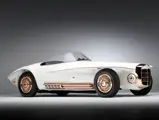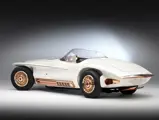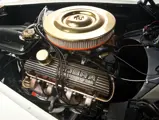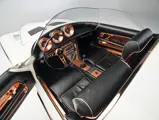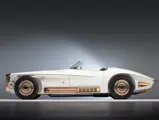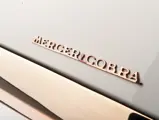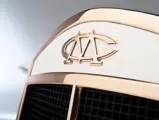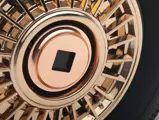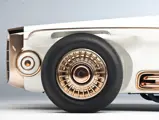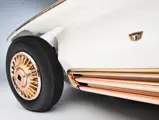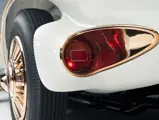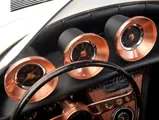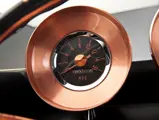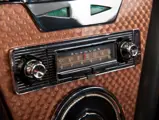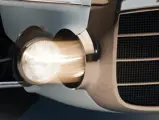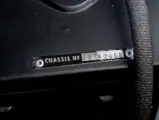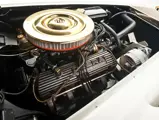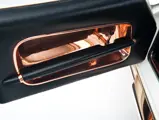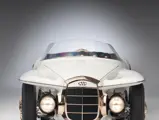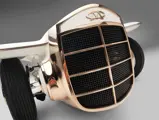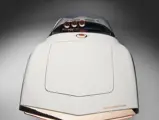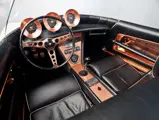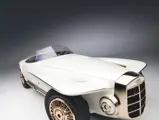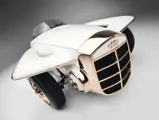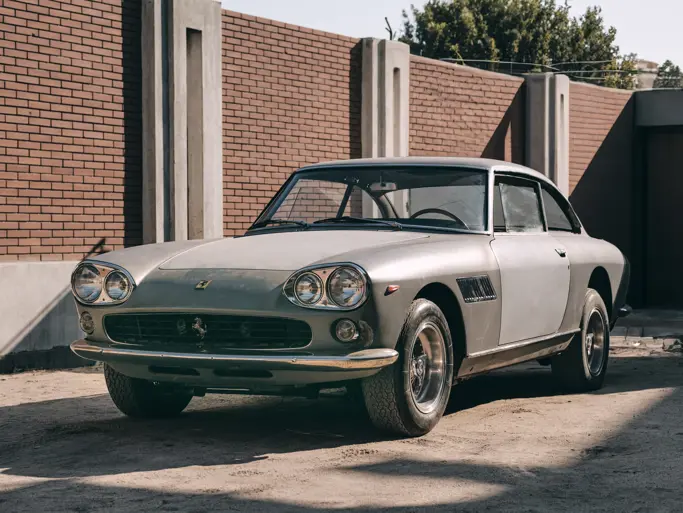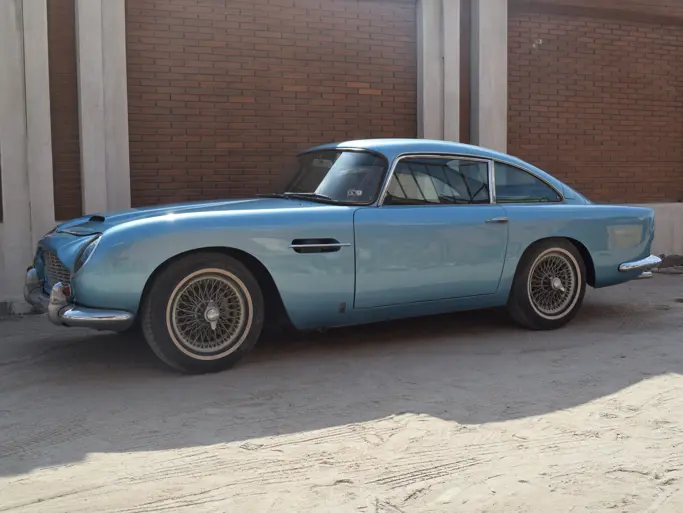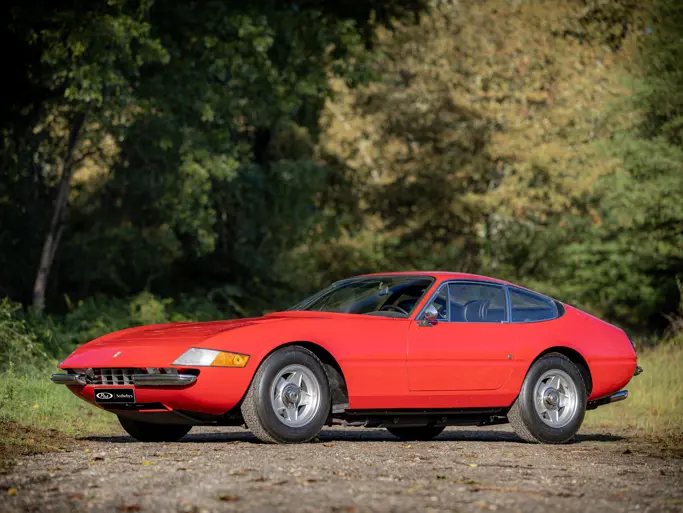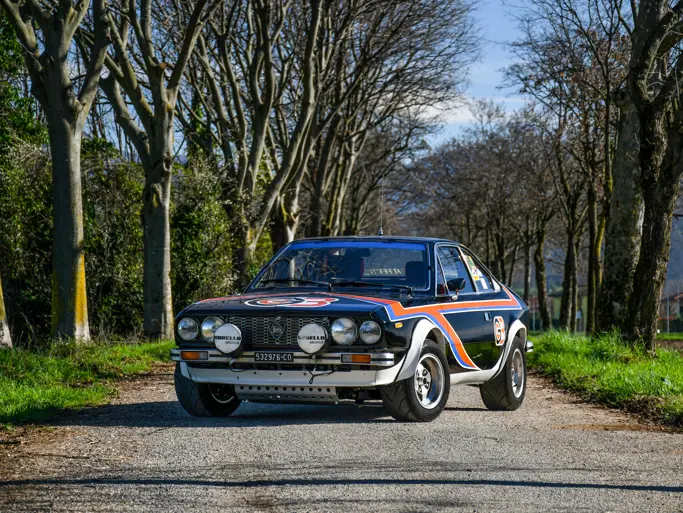Monterey 2011
1965 Mercer-Cobra Roadster
Lyon Family Collection
{{lr.item.text}}
$660,000 USD | Sold
 | Monterey, California
| Monterey, California
{{internetCurrentBid}}
{{internetTimeLeft}}

289 cu. in. V-8, four-speed manual transmission, four-wheel independent suspension with transverse leaf springs, four-wheel disc brakes. Wheelbase: 108"
- Ownership by Lyon Family Collection since 1989
- Commissioned by the Copper Development Association from Virgil Exner’s designs in Esquire
- The design vision of Virgil Exner and Virgil Exner, Jr.
- Modern interpretation of a Mercer Raceabout, built by Carrozzeria Sibona-Basano on Cobra chassis
- Numerous different finishes throughout to demonstrate the versatility of copper and brass
- Formerly in the collection of Joe Bortz
- Six-page spread in Automobile Quarterly (1964)
- Documented in Shelby American World Registry with chassis sold new through Shelby American
Following World War II, the automobile industry was alive with new ideas. Many were technical; overhead valve V-8 engines, automatic transmissions, torsion bar suspensions and effective, compact air conditioning were among the improvements on the engineering mind. Other concepts were design-oriented. In an era that headlined show and concept cars, manufacturers competed both within and between each other to display futuristic, idea-laden concepts. Designers quickly abandoned classic ideas in favor of streamlined, exotic and sometimes fantastic cars while quickly incorporating the successfully received concepts and important aerodynamic principles in the production automobiles sold to their customers. The designers, of whom many were already considered larger-than-life personalities, were elevated to celebrity status. As the products of the larger design firms affected even more facets of modern life, it was inevitable that the automobile, increasingly at the center of American society, would come under their influence. In the United States, industrial designers would quickly incorporate automobile-inspired styling into household appliances, service stations, furniture and corporate identity campaigns.
Virgil Exner
The first modern design to reach the market in practical form stole the edge from its competitors: the 1947 Studebaker Starlight Coupe designed by Raymond Loewy. Its flat flanks, forward thrust rear fenders and, most significantly, wraparound glass were a complete departure from the designs of the 1930s and ’40s. Even though Studebaker offered scant competition to Detroit’s Big Three, the 1947 model sent competitors rushing back to the drawing boards to revamp their postwar models. Loewy, as the company’s leader, took the credit, but it was Virgil M. Exner who designed the ’47 Studebakers, working from his home with clay modeler Frank Ahlroth with the explicit knowledge and approval of Studebaker engineer VP Roy Cole. Upon discovering the ruse, Loewy fired Exner; Cole hired him as a Studebaker employee the next day, but the uncomfortable situation persisted. Exner left Studebaker for Chrysler Corp. when his patron Roy Cole retired, eventually conceiving the redesigned “100 Million Dollar Look” Chryslers of 1955 and then the acclaimed and commercially successful “Forward Look” models of 1957.
At first Chrysler gave Exner his own studio specifically to conceive and produce one-off concept cars. Until then, show-car design and construction had been subcontracted to Italian coachbuilder Ghia with designs by Luigi Segre and Felice Mario Boano. A series of special designs followed which set the tone for Chrysler’s appearances at auto shows and influenced its design direction in the early ’50s, including the Dodge Firebomb, Plymouth Explorer, DeSoto Adventurer, Dodge Firearrow and Chrysler d’Elegance. All were built by Ghia from designs that emanated from Exner’s advanced design studio in Michigan. Exner’s appointment as Chrysler’s first Vice President of Design in 1957 came just after he suffered a major heart attack.
Design had become so important to Chrysler’s success that while Exner recovered successors had to be found, first William Schmidt from Studebaker-Packard and later Elwood Engel who would be Exner’s long-term successor at Chrysler. Upon retirement in 1964, Exner set up his own design consultancy. It included a design contract with Ghia from which emerged several successful Ghia show cars, notably the Selene II, and production designs for the Renault Caravelle and Volkswagen 1500.
Development of the Mercer Cobra
Even before formally retiring from Chrysler, Exner had been approached by Esquire magazine writer Diana Bartley. Her assignment: to seek out Exner’s ideas on the possibilities for modern designs of classic and antique cars and how such heritage could be expressed within the constraints of modern chassis and engines and customers’ increasing preference for comfort and luxury. The result was four famous designs. Exner freely expressed his long-nose, short-deck proportions in an effort to, as Exner put it, “capture the spirit of the older car design and body in a modern package … stress[ing] the development, and continuous refinement of a distinctive character for each marque, but also that the market for luxury cars can be greatly stimulated by some real effort to recapture some of the elegance and originality, which make many of the old cars so interesting and exciting to us yet today.” The December 1963 Esquire issue featured modern interpretations of designs for a Stutz Super Bearcat with a sliding retractable roof panel, a Duesenberg Dual Cowl Sport Phaeton, a Packard Convertible Victoria and a Mercer Raceabout. The concept was well received, and Exner had a chance to advance it in an October 1964 cover for True magazine with another four designs.
In the midst of this period of rapid evolution, preference of materials was also in flux. Aluminum and fiberglass both rose in importance as body materials. Interiors featured new synthetic fabrics. Plastics became stronger, weather- and ultraviolet-resistant and more versatile, allowing them to become viable low-weight replacements for metal castings and formings. An imaginative concept car attracted auto show spectators’ attention and, in direct proportion to it, the attention of designers in Detroit, Turin, Coventry and Stuttgart. Materials suppliers and their trade associations were active exhibitors, sometimes commissioning complete, running vehicles in their pursuit of visibility.
Copper Development Association and Carrozzeria Sibona-Basano
In the case of chassis number CSX2451, the Copper Development Association’s president, George M. Hartley, spied the Exner concepts on the pages of Esquire and contracted with Exner’s company to complete the design and have it built. With Ghia in financial trouble, Exner looked elsewhere for craftsmen capable of faithfully rendering the Mercer’s design features in metal. Brooks Stevens recommended Carrozzeria Sibona-Basano in Turin. The company had been established by Elio and Emilio Basano around 1962, but its capabilities and prestige were substantially augmented in 1962 when Pietro Sibona, one of Ghia’s master metal workers, joined them.
Exner and his son and business partner, Virgil M. Exner, Jr., completed the design utilizing a chassis from AC Cars in the U.K. to which Sibona-Basano faithfully and accurately adapted the design. Cobras were popular choices for specials builders and movie studios, as their series production and Ford-based drivetrain kept costs down.
In fact, CSX2451 is documented with a full history in the Shelby American World Registry, wherein it states the car was a custom project ordered new through Shelby American in February 1964, as Shelby was the exclusive U.S. distributor for A.C. It was invoiced to Shelby American as “one left hand drive chassis complete with front and rear axle assemblies, including disc brakes, road springs, 5 road wheels, 4 with tires and tubes. Engine and gearbox supplied free, issued by Shelby American, Inc. with installation kit, including radiator, petrol tank, all supplied, packed to chassis, including wiring and instrumentation.”
AC easily pulled chassis off the line before bodies were mounted and supplied them in nearly ready-to-run condition for rapid modification and construction; in the case of the Mercer-Cobra, the wheelbase was lengthened to 108 inches. Surviving period photographs which exist in the archives of the Henry Ford Museum show the clay model of the Mercer-Cobra in exceptional detail. Also in this collection are patent applications for the design of the body, as well as dramatic photos of the senior Exner supervising the design process. This collection of documents also indicates that the project was quite lucrative for the accomplished Exner; though the Cobra underlying the Mercer cost $2,800 with a total delivery price to Turin of $3,019 and the agreed price with Carrozzeria Sibona-Basano for the delivered coachwork was $10,400, the contract with the CDA was for a total delivery price of $35,000.
A Singular Concept
The Copper Development Association’s Mercer-Cobra exploited the dramatic colors and textures of copper and copper-based materials to its advantage, particularly with the Brass-Era theme of the Mercer. Some eleven different materials, alloys and finishes were employed in both the interior and exterior to demonstrate the diversity of copper and brass. Exner’s design emphasizes the long hood and pushed-back passenger compartment with long blade-style front fenders open along the hood sides, abbreviated rear fenders with separate mudguards behind the rear wheels and a long, tapered rear deck. A classic-style brass grille with eight large elements in front of mesh stone guards proudly leads the Mercer-Cobra’s design statement. The headlights are ingeniously mounted on pivots where they swing back flush with the sides of the nose when not illuminated. Exner later observed, “our overall aim was to create an interesting and stimulating design rather than one which simply follows the ‘formula’ of a flat, low snout with a horizontal air scoop and a squared-off bobtailed rear.”
For practical purposes, brass and copper elements were covered with an acrylic coating to prevent discoloration and exterior moldings made of silicon bronze. The taillights are recessed in brass tunnels integrated with the rear-wheel mudguards. Interior trim, seat backs, door panels and dashboard gauges are executed in copper while a high-strength chromium-copper alloy is used in the steering-wheel spokes. The 16-inch wire wheels have multi-piece brass covers. Chrome plating is used deftly but sparingly throughout, mostly on a brass substrate, to accent the richness of the brass and copper elements. The engine has been given the brass and copper treatment on the valve covers, air cleaner, oil filler cap and dipstick housing. This treatment continues in the silicon bronze heat shield protecting the body and passengers’ legs from the chrome-plated side exhaust pipes. Even the brake discs are made from copper alloy where the high heat-transfer rate promotes exceptional performance.
Finished in pearl white with black leather interior trim and a full-width curved Plexiglas windscreen, the Mercer-Cobra was toured throughout the world at shows and technical gatherings to promote copper and brass use and adaptability, making appearances on six continents. Delivered in late 1964, only a year after the decision to construct it was made, the Mercer-Cobra attracted worldwide attention, including a lavish six-page feature in the Winter 1964 issue of Automobile Quarterly. It was retained by the Copper Development Association for some ten years, demonstrating what an effective device it was in promoting the objectives of the association members.
Chassis CSX2451 was purchased by concept-car collector Joe Bortz in the early 1970s and was later owned by collectors Jim Southard, Al Wright and Tom Barrett. It has been owned by the Lyon family since 1989 – over 20 years. Although it was never intended to be driven, it is a running, driving functional automobile, still essentially as it was when it left Carrozzeria Sibona-Basano in late 1964, right down to the original tires. Recently the Mercer-Cobra concept car was displayed among a group of concept cars at the Pebble Beach Concours d’Elegance. Additionally, it participated in a special event at the University of Notre Dame in 2007 entitled “The Era of Exner,” which debuted Virgil Exner, Jr.’s new book about his father and presented several of Exner’s greatest automobiles, including of course the Mercer Cobra.
Not only is the Mercer-Cobra Roadster an important piece of America’s automotive design history, it is a rare surviving work by one of the great automobile designers of the 20th century, Virgil M. Exner. Designed solely by him and his son and built under their direct supervision, every facet and design detail reflects his concept and ideas and is a singularly pure statement of his vision.

